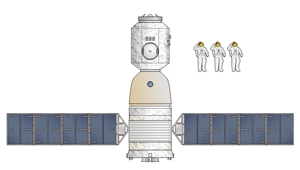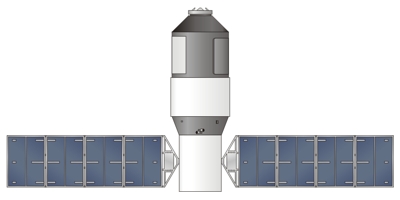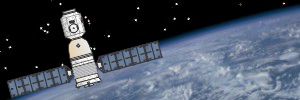Chinese Launch Vehicles
Chinese Rockets Overview
A CZ-2F rocket launched the first Chinese astronaut, Yang Liwei, into space in October 2003.
With this mission, the Chinese became the third country to launch a human into orbit.
Chinese orbital launches currently originate from one of four launch sites,
the Taiyuan Satellite Launch Center (TSLC), the Xichang Satellite Launch Center (XSLC),
the Jiuquan Satellite Launch Center (JSLC), and the Wenchang Space Launch Center (WSLC).
China is in the process of modernizing its space-launcher fleet.
New rockets being designed and introduced are more environmentally friendly than previous versions.
While previous Chinese launchers often used toxic hypergolic propellents,
the new designs use kerosene or hydrogen as fuel for the first and second stage engines.
Three new families of rockets are currently being introduced.
The CZ-6 small payload launcher first flew in 2015, the CZ-7 medium lift rocket
and the CZ-5 heavy lift rocket both maid maiden flights in 2016.
CZ-1 (Long March 1) Rocket

CZ-1
A CZ-1 rocket launched the first Chinese orbital satellite in 1970.
CZ-2 (Long March 2) Rockets
CZ-2 rockets are a series of hypergolic fueled satellite launchers. The rockets are typically two-stage, with some versions having four strap-on boosters. The CZ-2F version was the first Chinese rocket to launch humans into space.
CZ-2 rockets are sometimes referred to as Chang Zheng 2, Long March 2, or LM-2.

CZ-2C
The CZ-2C is a satellite launcher first flown in 1975. The first and second stages both use N2O4 and UDMH as propellants.
The rocket remains in service and several future missions are planned.

CZ-2D
The CZ-2D is a two-stage satellite launcher first flown in 1996. Both stages use N2O4 and UDMH as propellants.
Eleven successful CZ-2D missions have flown. The rocket remains in service and several future missions are planned.

CZ-2E
The CZ-2E launcher is a two-stage rocket with four strap-on boosters. Both stages, as well as the boosters, use N2O4 and UDMH as propellants.
The first test flight of the CZ-2E occurred in 1990. The rocket flew seven missions, two of which failed. The rocket last flew in 1995 and is no longer in service.

CZ-2F
 Shenzhou Spacecraft
Shenzhou Spacecraft
Developed from the CZ-2E launcher, the CZ-2F is used to support the Chinese human spaceflight effort. The primary payload has been the Shenzhou spacecraft.
The CZ-2F launcher is a two-stage rocket with four strap-on boosters. Both stages use N2O4 and UDMH as propellants. All CZ-2F flights are launched from Jiuquan launch center in Gansu province.
Shenzhou Missions
| Name | Launch
Date | Rocket | Crew | Mission
Objective |
| Shenzhou 1 | 19NOV1999 | CZ-2F | 0 | Test flight of Shenzhou capsule. |
| Shenzhou 2 | 9JAN2001 | CZ-2F | 0 | Test flight of Shenzhou capsule. |
| Shenzhou 3 | 25MAR2002 | CZ-2F | 0 | Test flight of Shenzhou capsule. |
| Shenzhou 4 | 29DEC2002 | CZ-2F | 0 | Test flight of Shenzhou capsule. |
| Shenzhou 5 | 15OCT2003 | CZ-2F | 1 | First Chinese human orbital flight |
| Shenzhou 6 | 12OCT2005 | CZ-2F | 2 | Orbital flight with two crewmembers. |
| Shenzhou 7 | 25SEP2008 | CZ-2F | 3 | First Chinese space walk.
Three person crew. |
| Shenzhou 8 | 31OCT2011 | CZ-2F | 0 | Unmanned test flight including automatic
rendezvous and docking with Tiangong 1. |
| Shenzhou 9 | 16JUN2012 | CZ-2F | 3 | Rendezvous and docking with Tiangong 1 space laboratory.
First Chinese woman in space. |
| Shenzhou 10 | 11JUN2013 | CZ-2F | 3 | Rendezvous and docking with Tiangong 1 space laboratory. |
| Shenzhou 11 | 16OCT2016 | CZ-2F | 3 | Rendezvous and docking with Tiangong 2 space laboratory. |

CZ-2F/G
Developed from the CZ-2E launcher, the CZ-2F/G is used to support the Chinese human spaceflight effort. The CZ-2F/G rocket first flew on 29 September 2011. The launch was successful and delivered the Tiangong 1 space station module to orbit.
The CZ-2F/G launcher is a two-stage rocket with four strap-on boosters. Both stages use N2O4 and UDMH as propellants. CZ-2F rockets are launched from Jiuquan launch center in Gansu province.
CZ-2F/G Missions
| Payload | Launch
Date | Rocket | Mission
Notes |
| Tiangong 1 | 29SEP2011 | CZ-2F/G | Test module for Chinese space station program. |
| Tiangong 2 | 15SEP2016 | CZ-2F/G | Test module for Chinese space station program. |
 Tiangong 1 Space Module
Tiangong 1 Space Module
CZ-3 (Long March 3) Rockets
CZ-3 rockets are a series of three-stage geosynchronous satellite launchers. Larger versions of the series can use two or four strap-on boosters. The first two stages, as well as the strap-on boosters when present, are fueled with hypergolic propellants. Third stages are cryogenically fueled.
CZ-3 rockets are sometimes referred to as Chang Zheng 3, Long March 3, or LM-3.

CZ-3
The three-stage CZ-3 rocket first flew in 1984. The last launch occurred in 2000.

CZ-3A
The CZ-3A rocket first flew in 1994. The rocket is still in service.

CZ-3B
The CZ-3B rocket first flew in 1996. The three-stage rocket includes four strap-on boosters.
An improved version, known as the CZ-3B/E first flew in 2007. Both the CZ-3B and CZ-3B/E models are still in service.

CZ-3C
The CZ-3C rocket first flew in 2008. The three-stage rocket includes two strap-on boosters.
The rocket is still in service.
CZ-4 (Long March 4) Rockets
CZ-4 rockets are a series of three-stage satellite launchers. The first CZ-4 flew in 1988.
CZ-4 rockets are sometimes referred to as Chang Zheng 4, Long March 4, or LM-4.

CZ-4B
The CZ-4B first flew in 2004.
CZ-5 (Long March 5) Rockets
CZ-5 rockets are sometimes referred to as Chang Zheng 5, Long March 5, or LM-5.

Configuration
The CZ-5 is a Chinese heavy lift space launch system.
The core stage uses liquid hydrogen (LH) and liquid oxygen (LOX) as propellants.
Four large boosters, surrounding the core stage, use RP-1 and LOX.
The restartable second stage burns LH and LOX.
An optional third stage is available for some missions.
First Missions
The maiden flight of a CZ-5 rocket was successfully flown in November 2016.
The second CZ-5, launched in 2017, failed to place its payload into the correct orbit.
Future Uses
It is planned the CZ-5 will be used to support the Chinese space station program and lunar program.
CZ-6 (Long March 6) Rockets

The CZ-6 rocket, sometimes referred to as Chang Zheng 6, Long March 6, or LM-6,
is designed to launch small payloads into space. The launcher first flew in 2015.
The first stage is powered by a YF-100 engine using RP-1 and LOX as propellents.
The second stage uses a YF-115 engine using RP-1 and LOX as propellents.
A small third stage uses hypergolic propellants.
CZ-7 (Long March 7) Rockets

The CZ-7 is a medium lift rocket that first flew in 2016.
CZ-7 rockets are sometimes referred to as Chang Zheng 7, Long March 7, or LM-7.
The first stage is powered by two YF-100 engines using RP-1 and LOX as propellents.
The rocket is designed to include up to four strap-on boosters.
Each booster is powered by a single YF-100 engine.
The rockets second stage uses four YF-115 engines, also using RP-1 and LOX as propellents.
Both hypergolic and hydrogen/oxygen upper stages are available as needed.
The CZ-7 is expected to replace the CZ-2F/G rockets supporting human spaceflight.
References
China Great Wall Industry Corporation
China Aerospace Science and Technology Corporation
 Images by Richard Kruse are licensed under a Creative Commons Attribution-Noncommercial 3.0 United States License.
Images by Richard Kruse are licensed under a Creative Commons Attribution-Noncommercial 3.0 United States License.










 Images by Richard Kruse are licensed under a Creative Commons Attribution-Noncommercial 3.0 United States License.
Images by Richard Kruse are licensed under a Creative Commons Attribution-Noncommercial 3.0 United States License.